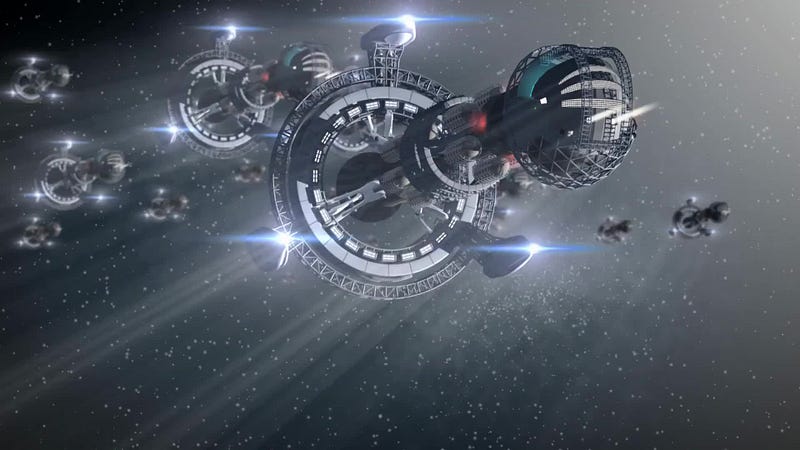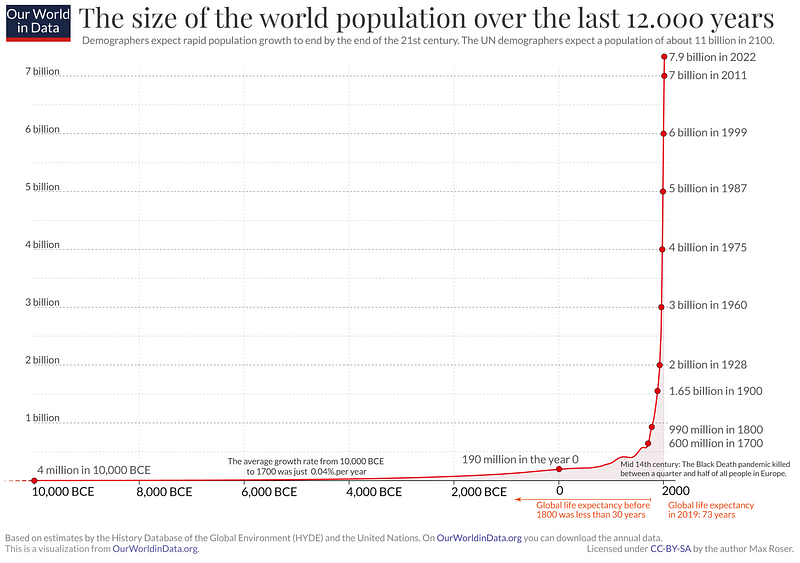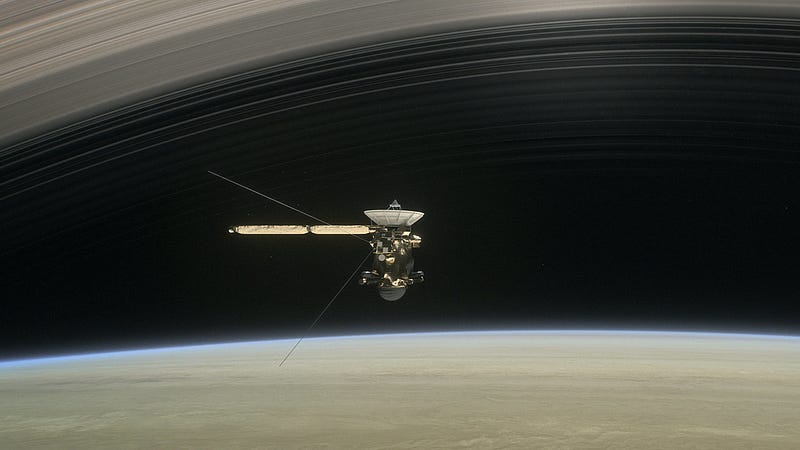The Enigma of Extraterrestrial Visits: Reasons for Their Absence
Written on

As astronomers delve deeper into the mysteries of the Universe, we increasingly recognize that Earth and its inhabitants represent only a tiny fragment of a vast cosmic landscape. Estimates suggest that our Galaxy alone may host around 300 million planets capable of supporting life, with approximately 2 trillion galaxies in the entire Universe. Moreover, the Universe is estimated to be around 13.8 billion years old, while human history spans a mere 200,000 years—a blink of an eye in cosmic terms. This presents countless opportunities and ample time for extraterrestrial civilizations to emerge.
Should such civilizations exist, some might be millions, or even billions, of years old. Theoretically, these advanced beings would possess the technology to traverse the Galaxy, yet we find no evidence of their presence. So, where could they be?

A Presumed Interest in Earth
Throughout this discussion, we have taken for granted that extraterrestrials would have an interest in visiting Earth. However, this assumption is not universally accepted. This article will examine three reasons why aliens may not wish to come to our planet, even if they have the means to do so.

Dyson Spheres
If extraterrestrial civilizations are indeed seeking to colonize the Galaxy, they would likely search for suitable locations for their colonies. Would they consider our Sun, a stable G2-type star, and Earth, a rocky planet abundant in liquid water, as ideal options? Perhaps, since Earth is the only confirmed location that can sustain life, it may attract their interest.
However, they might have entirely different criteria. The physicist Freeman Dyson proposed that advanced civilizations might opt to build Dyson Spheres—an idea introduced in a 1960 paper he published in Science. Dyson theorized that as technological civilizations evolve, their energy demands grow. Eventually, this could lead them to require the total energy output of their star, prompting the construction of a series of orbiting structures to capture all the stellar energy.

Although Dyson Spheres are currently beyond our engineering capabilities, more advanced alien civilizations might find them feasible. If they pursue this path, they would likely target the most luminous stars to build these energy-collecting structures, potentially neglecting our Solar System if it does not offer the best economic benefits.

The Cost Factor
Many scientists agree that humans are a remarkably successful species, with 99.9% of all species that have ever existed on Earth now extinct. A look at the human population over time reveals a sharp increase, particularly since the Industrial Revolution around 1800 AD. It took until then for the human population to reach 1 billion, but just 200 years later, it surged by an additional 7 billion. This explosive growth showcases human ingenuity in controlling and adapting our environment, but it is not sustainable indefinitely.
So, what could put an end to this trend? Perhaps we will deplete our resources, as Earth's supplies are limited. Even if we expand our reach to mine resources within our Solar System, those are finite too. Should we exhaust our resources, our civilization could face collapse. If alien civilizations encounter similar challenges, it might explain their absence in our Galaxy—perhaps the effort to reach us simply demands too many resources.

The Zoo Hypothesis
The final point to consider is the Zoo Hypothesis. Before delving into it, it is essential to clarify that scientists propose hypotheses to explain the unknown, expecting them to be subject to empirical validation. The Zoo Hypothesis, however, cannot be tested, which raises questions about its scientific validity. Nonetheless, it remains a thought-provoking concept.
The Zoo Hypothesis posits the following: - It assumes that extraterrestrial civilizations are widespread throughout the Universe and that some will evolve technologically. - The most advanced civilizations will dominate, while lesser ones may face extinction, control, or assimilation. - This raises the question of how these powerful civilizations would choose to interact with us.
Earth and our Solar System might be perceived as a "zoo," maintained by these advanced extraterrestrial civilizations, akin to how humans create wildlife sanctuaries or zoos for various species.

The motivations behind such an action are speculative. Perhaps these advanced beings wish to remain hidden and possess the technology to achieve that. It is possible that their ethical principles prevent them from interfering with the natural evolution of life forms outside their home world.
This theme is explored in the well-known science fiction series Star Trek, where Starfleet, the exploratory and defensive body of the United Federation of Planets, follows the Prime Directive. This rule prohibits Starfleet personnel from interfering with the natural development of "pre-warp civilizations," which have yet to develop faster-than-light travel. Consequently, they remain concealed from these less developed societies.

In a way, humanity adheres to a similar moral code. During its mission, the Cassini space probe uncovered a subsurface ocean of liquid water on Enceladus, one of Saturn's moons, suggesting potential native life. To prevent contamination, NASA opted to crash Cassini into Saturn, allowing it to disintegrate in the planet's atmosphere rather than risk crashing into Enceladus.
The Zoo Hypothesis faces several critiques. For one, if we cannot peer through this "zoo's" veil of secrecy, it raises questions about its scientific merit. Additionally, critics argue that the hypothesis is anthropocentric—why would advanced aliens be particularly interested in us? The most significant criticism is based on the assumption that extraterrestrial civilizations are prevalent in the Universe. If true, it only takes one rogue civilization to expose this charade to Earth, yet that has not occurred—at least not yet.
Thank you for reading and sharing! If you enjoyed this article, consider becoming a Medium member through my referral link here to access unlimited content for only $5/month. I would appreciate your support as a writer.
If you found this article interesting, you may also like: 1. The Fermi Paradox: Where Are All the Aliens? — Exploring the question of our solitude in the Universe. 2. How Many Advanced Extraterrestrial Civilizations Are in Our Galaxy Today? — A look at the Drake Equation and its calculations. 3. 3 Times in History When Scientists Thought We Made Contact With Aliens— Examining historical moments of perceived extraterrestrial communication.
Citations 1. Saad, Lydia. “Do Americans Believe in UFOs?” Gallup.com, Gallup, 20 Nov. 2021, https://news.gallup.com/poll/350096/americans-believe-ufos.aspx. 2. How many habitable planets are out there? SETI Institute. (n.d.). Retrieved April 20, 2022, from https://www.seti.org/press-release/how-many-habitable-planets-are-out-there 3. Dyson, Freeman J. “Search for Artificial Stellar Sources of Infrared Radiation.” Science, vol. 131, no. 3414, 1960, pp. 1667–1668, https://doi.org/10.1126/science.131.3414.1667. 4. “Measuring the Age and Size of the Universe.” ESA/Hubble | ESA/Hubble, https://esahubble.org/science/age_size/. 5. Weidner, C., and J. S. Vink. “The Masses, and the Mass Discrepancy of O-Type Stars.” Astronomy & Astrophysics, vol. 524, 2010, https://doi.org/10.1051/0004-6361/201014491. 6. “Evolution: Extinction: A Modern Mass Extinction?” PBS, Public Broadcasting Service, https://www.pbs.org/wgbh/evolution/extinction/massext/statement_03.html#:~:text=Of%20all%20species%20that%20have,of%20a%20sixth%20mass%20extinction. 7. Roser, Max, et al. “World Population Growth.” Our World in Data, 9 May 2013, https://ourworldindata.org/world-population-growth. 8. Ball, John A. “The Zoo Hypothesis.” Icarus, vol. 19, no. 3, 1973, pp. 347–349, https://doi.org/10.1016/0019-1035(73)90111-5. 9. “Prime Directive.” Memory Alpha, https://memory-alpha.fandom.com/wiki/Prime_Directive. 10. “The Grand Finale.” NASA, NASA, 17 Feb. 2022, https://solarsystem.nasa.gov/missions/cassini/mission/grand-finale/overview/.